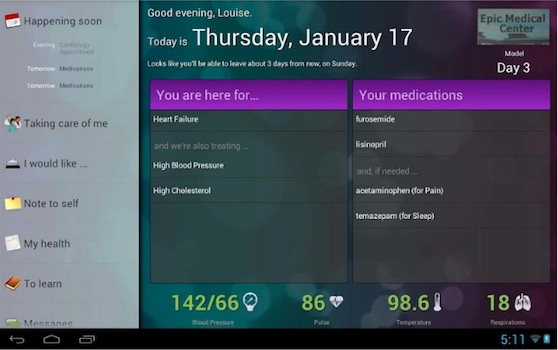 The Ohio State University Medical Center has seen a considerable spike in mobile visitors to its website. In January 2012 the medical center noticed that about 13 percent of its website visitors were viewing it on their mobile devices, but by January 2014 that percentage has jumped to about 40 percent. Those and other data points helped convince the medical center to move away from text-heavy website designs and to a "mobile first" strategy, Megan Stanley, the senior director of digital strategy at OSU Medical Center explained to attendees during a presentation at HIMSS 2014 in Orlando this week.
The Ohio State University Medical Center has seen a considerable spike in mobile visitors to its website. In January 2012 the medical center noticed that about 13 percent of its website visitors were viewing it on their mobile devices, but by January 2014 that percentage has jumped to about 40 percent. Those and other data points helped convince the medical center to move away from text-heavy website designs and to a "mobile first" strategy, Megan Stanley, the senior director of digital strategy at OSU Medical Center explained to attendees during a presentation at HIMSS 2014 in Orlando this week.
"Even these numbers from two months ago have already changed," she said. "The experience for mobile visitors can be very frustrating -- where nothing is legible on the screen. We wanted to move away from that, but we also didn't want to manage separate sites [for desktop and mobile]. So we looked into responsive -- also known as adaptive --design, which is an approach to design your templates and tools to adapt to any screen size. It looks at the thousands of different screen sizes that are out there and adapts your website accordingly."
OSU Medical Center is also working to drive uptake of its patient portal, OSUMyChart -- the patient-facing health record app and portal developed by Epic Systems. Stanley said that because Meaningful Use Stage 2 requires that five percent of patients be actively using their MyChart tool and that 50 percent of new in-patients must be offered the tool, it was important for OSU to rally its marketing and IT teams as well as its clinicians to get the word out.
"While this could just be considered an IT project working with the clinicians, marketing has a very important role to play because we want to connect that experience with them online," she said. "We want to help them learn more about the benefits of MyChart and that they can come to MyChart to do 'x' and continue on to do other things as well."
The medical center is also piloting a new iPad app from Epic called MyChart Bedside.

"We are the second in the country to pilot this," Stanley said. "When you are in the hospital you are given an iPad and you can engage with your patient record in a lot of different ways that are contextual to your in-hospital experience. This is different than your MyChart experience, which is for when you are sitting at home or on the go. [OSUMyChart Bedside] is focused on what you need when you are in the hospital. It gives you your results and allows you to communicate with your care team. You can learn more about your condition or disease through patient education materials."
Stanley said that because they are handing their patients iPads for the duration of their stay, patients were thrilled. "It was just a tremendous outpouring of excitement coming from the patients involved with the pilot," she said. And while she didn't mention the increasing importance of patient satisfaction scores, the pilot likely boosted them. Stanley shared a quick anecdote about one such satisfied patient:
"Around Christmas time there was a mother who was admitted and, of course, she was stressed because it was right before Christmas and she had a lot to do to help her children have a good holiday season," she said. "One of those things was that she hadn't finished her Christmas shopping yet. By giving her a tablet -- she could do all those things related to her health record -- but she could also finish her Christmas shopping. That actually reduced her stress, which helped with her healing."
Stanley said that later this year OSU is expanding with a new cancer hospital and critical care center on its campus. When those go live, Stanley said they will be rolling out the Epic MyChart Bedside app to all patients admitted into the new facilities, which would be the largest rollout of the app, she said.
OSU Medical Center's CIO Phyllis Teater also revealed that the medical center had done a few pilots focused on patient reported data, when asked by a HIMSS attendee.
"That is one of the next frontiers, and it includes thinking about how we provide some of that data to our clinicians in such a way that is clear. It's not just about making sure the data is accurately reported, but also that it helps the provider with any treatment decisions that they might have. [Sharing patient generated data with providers] also really starts a conversation with the patient, so we are starting down that road but we are not very far."
















